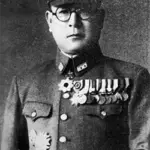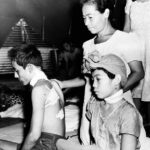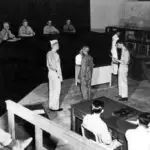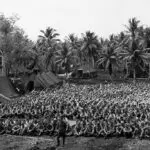US Navy War Crimes Trials in Guam
Table of Contents
Share This
Begun in late 1944
Some months before the end of the Pacific War, the US Navy impaneled a war crimes commission for Guam. The responsibility of the commission, a national one rather than an international one as at Nuremberg and Tokyo, was to bring to trial suspected Japanese and native war criminals. This was in response to reliable information that enemy forces, both German and Japanese, had carried out illegal practices unprecedented in past conflicts.
The US Navy War Crimes Commission in Guam (commonly called the Guam war crimes trials) functioned like a grand jury and Captain (later Rear Admiral) John D. Murphy was appointed director of the commission in October 1945, although the commission began its work in late 1944. Murphy was a lawyer, a member of the federal bar, co-author of a manual on international law relating to naval warfare, and had pre-war military service in Asia. His first order of business was to have his staff carry out research regarding:
- procedures for investigation of alleged war crimes
- laws and authorities concerning such crimes
- jurisdiction
- types of tribunals
- powers and procedures for tribunals
- judgments and their execution
- control and treatment of suspected war criminals and witnesses
The purpose of this research was to establish a fair and legal method of operation, knowing full well that the Navy commission and its work would be criticized as one of “victor’s justice.”
Because Japanese troops in the Pacific had been repatriated as quickly as possible after hostilities ended, it was necessary for Murphy to confer with General Douglas MacArthur, Supreme Allied Commander, in Tokyo in order to expedite evidence gathering and apprehension of suspects. There was at least one suspect, Lt. Col. A. Miyazaki, who was found and detained for his role in the execution/murder in Palau of six Jesuit missionaries, the Hondonero-Untalan family of parents and two children, and probably three or more US B-24 airmen in Ngatpang, Palau, in September 1944. Miyazaki, however, committed suicide in Japan before he could stand trial in Guam.
These factors led to the establishment of a liaison office in Tokyo to coordinate the search for suspects and, equally important, the recruitment of Joseph Keenan as the chief prosecutor of the Tokyo International Tribunal for service with the Navy Commission at Guam.
Strove for impartiality
The Navy Commission was a national court and its members represented every branch of the US military. The commissioners were continually changed “in an effort to preserve impartiality, and provide divergent backgrounds…and stable emotional qualities.” Like a court, the commissioners heard cases, listened to arguments of both prosecution and defense, deliberated, and recommended punishment.
While the Navy provided prosecutors, the defendants, mainly Japanese, had defense attorneys both American and Japanese. The latter were cleared through General MacArthur’s headquarters and were leading Japanese civilian attorneys. The Navy provided them with transportation, meals and housing, but these defense attorneys worked without compensation. The commission conducted its trials in an large “elephant” quonset on Nimitz Hill. Although the Quonset is gone, its site is now on the National Register of Historic Places with the US Department of the Interior.
Some CHamorus/Chamorros tried
The Guam Commission tried fifty-one cases involving 144 persons during the span of the trials – 1944 to 1949. Of this total, 127 were Japanese, thirteen were Chamorros from Saipan, two Chamorros from Rota, one was a Chamorro from Guam and one a Chamorro from Palau. In the investigation and evidence gathering process, some 550 suspected war criminals were identified but 404 of that total were not charged with any specific crimes. Of the 144 tried, eight were acquitted and two committed suicide. This resulted in some 47 cases that charged some 134 individuals of murder, torture and cruelty, assault and mistreatment, starvation and neglect and other violations of the law and customs of war, violation of Guam criminal law, violation of Japanese criminal law or violation of international law.
The cases most relevant to Guam were those involving Chamorro from Saipan who had been drafted by the Japanese to serve as assistant policemen or interpreters during the thirty months of Japanese occupation of Guam. These were the very first cases processed from July to November 1945, and most of the individuals tried were Chamorros from Saipan who had grown up during the Japanese mandate and territorial rule of Micronesia, were Japanese speaking, and more loyal to their colonial rulers than to their fellow Guam Chamorros. There were at least thirteen Saipanese convicted of murder, torture, cruelty, assault or mistreatment.
Much of this criminality took place in relation to the Japanese search for US Navy radioman George Tweed. Because the Japanese high command believed Tweed was in radio contact with the American military, their search was very intensive and investigative techniques harsh and brutal.
Of the thirteen Saipanese arrested for committing war crimes in Guam, five of them—Juan Reyes, Antonio Camacho, Manuel T. Borja, Luis C. Crisostomo and Juan Villagomez—were initially sentenced to death or life in prison. Upon review of their cases at levels beyond the commission, four of the death sentences were commuted to life in prison. It is not known how many years each of them in fact spent behind bars. Reportedly, they were “exiled” to Saipan.
The one Chamorro from Guam tried and found guilty of assaults and mistreatment was Miguel A. Cruz. His case was the fourth processed in March 1945. Cruz served as a Japanese district official at the time of his offenses and was sentenced to one to ten years imprisonment.
In a time of chaos
Most of the criminality of the Saipan Chamorros against the Guam Chamorros took place before July 1944. The two- to three-week period in July 1944 that preceded the American invasion was marked by near total chaos: round the clock bombings, a breakdown of military morale, discipline and communications, and shortages of food and war supplies. This was the time when much of the killings and brutality against the Chamorros by the Japanese military took place; including the murder of Father Jesus Duenas, his nephew and two other men; the murder of sixteen Chamorros at Tinta (14 Chamorros survived by playing dead); and 30 at Faha; the brutalization and attempt to kill nearly 90 Chamorros at the Fena caves where 32 perished and 57 survived; the senseless killing of 11 men, women, and children in Hagåtña on July 20; the rape-murder of nearly a dozen teenage Chamorro girls in Hågat, and on or about August 8 or 9; the beheading of 45 young Chamorros who had carried war supplies to Yigo for the Japanese military.
Chamorro murders not investigated
Ironically, personnel from the war crimes commission did not investigate these murders. Apparently, charges were not filed or brought forward to the commission because case files on these crimes do not exist. The war had left the Chamorros in complete shock, fear, and social disruption. How would they eat? Where would they live? Who was missing? When would life be normal again? Answers to these questions were first and foremost. Under these conditions filing charges was not a priority. Another part of the explanation must be that the Japanese responsible for this criminality were, themselves, killed during the intense fighting. There were relatively few Japanese survivors of the battle for Guam.
Remembrance of Chamorro sacrifices takes place each year at Tinta and Faha in Malesso’, as well as more recently at Fena in Sånta Rita-Sumai. However, the 45 Chamorro youth who were beheaded in Yigo were nearly forgotten. It was only in early 2001 when former Congressman Robert Underwood tracked down the names of 38 of the 45 Chamorro youth and began talks with the US Air Force regarding construction of a monument in commemoration of the sacrifices of these young people at the place where they died. Unfortunately the September 2001 terrorist attacks on New York City interrupted this effort.
Even though much of the Japanese criminality in Guam was apparently not reported to the Navy Commission, a number of horrendous crimes committed on other islands in the Pacific were reported, investigated, tried and punished.
Death by hanging
For war crimes committed against American prisoners of war (POWs) or civilians working for the military (as at Wake Island) in the Marshalls, Chuuk, Wake Island, and Chichi Jima, the commission processed some twenty-three cases resulting in convictions and thirteen death sentences. The sentences were carried out by hanging in 1947 and 1949 reportedly at the Commander Naval Forces, Marianas Headquarters (COMNAVMAR).
Twelve of the thirteen men were Japanese Army or Navy officers. Their trials were locally sensational and made front-page coverage in the Navy News and, later, the Guam News. Included among those hanged in 1947 were Lt. General Tachibana and Lt. Col. Ito. They were found guilty of torture, murder and cannibalism on Chichi Jima. Another Japanese officer of some repute, Rear Admiral Sakaibara, was found guilty of the murder of ninety-eight civilian POWs, most were Chamorros from Guam, on Wake Island in 1943. Additionally, Surgeon Captain Hiroshi Iwanami was found guilty of murdering ten American POWs. Rear Admiral Shimpei Asano and Surgeon Commander Chisato Ueno were found guilty of torturing and murdering four American POWs at Chuuk and Kwajalein. Evidence was found that Iwanami, Asano, and Ueno had allowed or conducted medical experimentation and mutilation of the bodies of the POWs.
Finally, in 1942, the Navy Commission determined that Vice Admiral Koso Abe ordered and supervised the beheading of nine US Marine commandos on Kwajalein. He, too, was found guilty of murder. All seven high-ranking officers, Tachibana, Ito, Sakaibara, Iwanami, Asano, Ueno, and Abe were hanged and buried in unmarked graves on US military land in Guam.
Evidence put aside
It should be noted that the US Navy had considerable evidence of the Yigo murders, sometimes called a massacre, and direct, eyewitness testimony of the murderous act of a Japanese naval reserve lieutenant in killing some 16 Chamorros using hand grenades and bayoneting at Tinta. Inexplicably these crimes were not brought to trial. Excepting the mass murders at Wake Island, it could be argued that crimes against American servicemen were taken more seriously—and punished more severely—than Japanese and Saipanese crimes against Guam Chamorros.
For further reading
Addison, Paul. “U.S. War Crimes Trials: One Man’s Story.” Journal of the Pacific Society 18, no. 3 (November 1995).
Erickson, George E. “United States Navy War Crimes Trials (1945-1949).” Washburn Law Journal 5, no. 1 (Winter 1965): 89-111.
Higuchi, Wakako. “The Japanese Military Occupation of Guam, 1941-1944.” MA thesis, University of Guam, 2000.
Maga, Timothy P. “Judgment on Guam.” In Judgment at Tokyo: The Japanese War Crimes Trials. Lexington: University Press of Kentucky, 2001.
Mercer, Scott A. “The Guam War Crimes Trials: A Re-Examination Through a Comparison with the Yamashita and Homma Trials in Manila.” MA thesis, University of Guam, 2001.
Rogers, Robert. Destiny’s Landfall: A History of Guam. Honolulu: University of Hawai’i Press, 1995.
Wibur, George. “Five Japanese Military Criminals Executed on Guam for Atrocities: Hanged Quietly in Interior of Guam.” Navy News, 26 September 1947.




